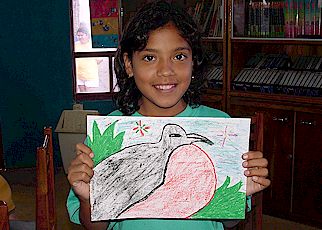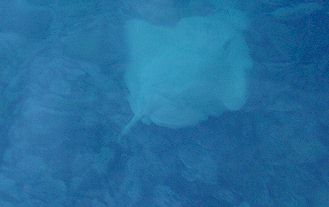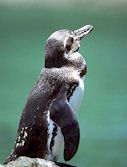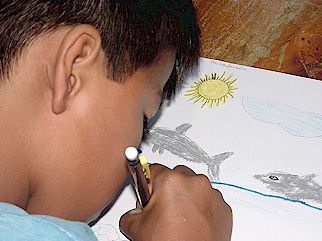Dear students,
Hola. Que hay de nuevo? Hello, what's new? Greetings from the town of Puerto Villamil on Isabela Island. Isabela is, by far, the largest of the Galapagos Islands (4,588square kilometers), the twelvth largest island in the South Pacific and the only Galapagos Island to straddle the equator. It consists of five major volcanoes (Cerro Azul, Sierra Negra, Alcedo, Darwin, and Wolf) and one minor one (Ecuador) whose lava flowed together over the course of many volcanic eruptions and millions of years to form a single landmass. Isabela boasts the archipelagos tallest mountain, (though authorities differ on which one it is: some books say Wolf Volcano is the tallest, at 1,707 meters, while others put Wolf at 1,646, making Cerro Azul the tallest at 1,689 meters above sea level); the third largest town, Puerto Villamil, at around 1,000 people, and the most subspecies of Galapagos Tortoises, at five, one for each large peak.
Along
with its western neighbor, Fernandina, the youngest of the islands, and
Marchena, the largest island completely north of the equator,  Isabela
has had relatively recent volcanic eruptions, the latest being in 1979. Your
teacher has some addresses for Web sites about volcanic activity in the Galapagos
and volcanoes around the world - and one that provides a cool 3-D view of Isabela
Island.
Isabela
has had relatively recent volcanic eruptions, the latest being in 1979. Your
teacher has some addresses for Web sites about volcanic activity in the Galapagos
and volcanoes around the world - and one that provides a cool 3-D view of Isabela
Island.
Today and yesterday, we visited the only school in Puerto Villamil, Escuela Cornelia Izquierdo. The teachers and students were very enthusiastic about participating in the project, but since they were getting ready for Christmas programs and holding teacher meetings, we couldn't meet with as many classes as we wanted to. We did complete art exchanges with a few classes, however, and made a video about Puerto Villamil and Isabela with a group of fifth grade students.
For me, the neatest parts of making the video were searching for food (crabs, snails and octopuses) alongside whimbrels, knots and sanderlings on patches of lava washed by the waves on the beach; climbing a tiny volcano just outside of town; and swimming in Concha y Perla, a mangrove cove protected from the open ocean by a ring of rocks.
The students were especially excited about swimming with us at Concha y Perla because, as they explained, they were only allowed to swim when adults were present. They explained how a schoolmate of theirs named Magalay drowned in the ocean earlier in the school year. She was swimming with her classmates and teacher when a strong undercurrent pulled her under and into deep water and before anyone could react, she was gone. It was a sad story and the event strongly affected her classmates and schoolmates.
==============================
We met a singer/musician in town who, along with some other musicians, wrote a song called Magalay that went like this:
Ñaña
linda duermase
Los de mas acuerdense
Ñiña de Galapagos
La devolvemos a dios
Como
no estuve alli en su momento desesperado?
Como fuimos tan lentos, dejando que se vaya mi hermanita?
Pudo
haber sido mi propia hija
Parece que caminamos en un hilo fino
Que de bueno hice hoy?
A caso importa?
In
English it goes like this:
Little sister, sleep in peace
Everyone else, remember
The little girl from Galapagos
That we gave back to God
How
could I have not been there
On the brink of your despair?
How could we have been so slow
To let my little sister go
She
might have been a child of mine
Seems we walk a fragile line
What good did I do today?
Does it matter anyway?
They wrote the song for Magalay and her family.
===============================
On a more cheerful note, believe it or not, just as the people of Puerto Villamil were getting ready for Christmas, putting up artificial Chrismas trees and stringing colorful lights on their homes, Lilia and I actually met Santa Claus! That's right, the one and only Santa Claus, you know, long white hair, long white beard (tied in braids when we saw him), bulging belly, red nose, jolly laugh, Santa Claus! -- in the one place in the world you would least likely expect to see him - on the equator. He lives a simple life in a simple house on the Puerto Villamil beach with a dog named Lulu, a cat named Tyson, a Galapagos hawk named Guapo and a baby pig named Lucy. He invited us over for cake and told us that having lots of things isn't so important, but living in a way that doesn't hurt others or the environment is. He said, 'You have to laugh at life, even though it's hard sometimes.' Yes, believe it or not, we met Santa Claus. (Sorry we don't have a photo of him!)
OK, well, maybe I should revise that a bit: we can't really verify his claim, but he did play Santa Claus in an Ecuadorian TV commercial for Durex batteries, in which he says, pulling on his beard, 'Soy de verdad.' ('I'm the real thing.') In Isabela, he's also known as Gringo Juan. So maybe he wasn't really Santa, but he is a colorful character, with a simple but eloquent message: take care of nature and it will take care of us.
=============================
Well, today we lost our perfect record. That's right, on the boat ride from
Isabela to Floreana, Lilia fed the fish! We stayed on Floreana just long enough
for Lilia to catch her breath, refill her empty stomach with lunch and take
some sea-sickness medicine -- and she managed the day's second boat ride, from
Floreana to Santa Cruz, without sharing her meal. Pobrecita! Oh well,
she feels much better now that we're back on dry land -- and nine out of ten
isn't  such
a bad record, really. I can't rub it in too much, though, since I still feel
pretty woozy from the rocky rides.
such
a bad record, really. I can't rub it in too much, though, since I still feel
pretty woozy from the rocky rides.
On the way to Floreana, we saw a couple new animals (for us), a Morello shark and masked boobies. While on Floreana, we briefly visited the only school on the island - which has a whopping 18 students. Unfortunately, we couldn't get a boat to the island earlier in the month and we were not able to work with the students there.
Tomorrow we fly back to Quito. We don't really want to leave this incredible place but, as they say, 'all good things must come to an end.' But, they also say, 'one good thing leads to another:' After our Galapagos project, we'll be heading to the Amazon Rain Forest to start another project there.
. ==========================
Guess-Who!
Here's this report's guess-who animal math poem. Guess who and figure out the math posed by the animal. Check our Incredible Animals of the Galapagos Web site section for the answer and the math solution.
Exponential
Stature
I'm all furrows and fissures,
rigid and dry/ Like a lonely old volcano,
wrinkled and shy/ And like the layers of lava named
after me/ I've gained my stature slowly and exponentially/
Only a tenth of a kilogram shortly after incubation/ I was ten
times that by my first birthday celebration/ And ten times that by the
time I reached first grade/ And ten times that again by the end of my third
decade/ And after a dozen more decades, I'll finally reach my end/ By then I'll
have doubled plus a half again/ Can you figure out my weight, my age and who
I am?
I'm all furrows and fissures, rigid and dry/ Like a lonely old volcano, wrinkled
and shy.

The last report's poem was about the Galapagos Penguin. Go here to read why 23 degrees Celsius is such a critical temperature for the most northerly of penguins. Twenty-three degrees Celsius, by the way, is equivalent to 73.4 degrees Fahrenheit.
============================
Question-and-Answer Exchange
Here's the last batch of questions and answers.
Are
some of your fathers fishermen?
Yes.
Do
you ever help them?
Yes.
 Do
they ever fish illegally?
Do
they ever fish illegally?
No, but some people do.
Why
do people fish illegally if they know the fish are endangered?
Because they can make a lot of money doing it, even
though it can be dangerous.
How
do you feel about the tourists and scientists that come to visit you?
We are glad they come to our islands and we want more
of them to come. The scientists have made our islands famous and they teach
us how to take care of the islands and our animals. The tourists help us to
make a living and mostly they are friendly.
How do you get supplies and water for your island?
We import a lot of supplies, including bottled water,
from the continent (mainland Ecuador). We also have desalinators to take the
salt out of ocean water and make it drinkable.
What
do you do with your garbage?
We put it in dumps outside our town - or some people
burry it in holes in the ground.
============================
Well, that's all for this report and, sniffle, sniffle, this is the last report of the project. We hope you've enjoyed traveling with us -- and hope you'll join us for another project soon! Till then....
Learn lots,
Paul and Lilia
==================================
Teachers: Here are some volcano links and a link to a site that provides a 3-D view of Isabela Island.
Absolutely Volcanic Web Site -- This colorful site is designed to provide quick and easy access to volcanic images. Selections include the most active volcanoes, eruptions and lava flows. Isla Isabela 3-D This is a three-dimensional view of Isabela, one of the Galapagos Islands.
Volcanoes.com -- Links to many volcano sites.
How Volcanoes Work -- Explores the science behind volcanoes.
Volcano World -- From the University of North Dakota, 'the Web's premier source for volcano information,' including a Kids' Door for younger students. Find out about currently erupting volcanoes, take a virtual field trip, read an interview with a volcanologist, and read the archives of an outstanding Ask a Volcanologist question and answer service.
Also,
Lilia and I have created three new sections of the Galapagos Islands School
Project Web site. They are lots of fun, so have a look! To visit students at
the Tomas de Berlanga School, go here.
Visit, Incredible Animals
of the Galapagos, featuring the guess-who animal math
poems from the E-travel logs, with audio of the 'animals' reciting or rapping
their poems, plus photos of the animals; and Mystery
Animal Profiles, modeled
after the guess-who pelican photo series from the E-mail reports and featuring
six Galapagos animals.
Index
Page
Meet the Adventure Team
E-Log#1:
New York
E-Log#2: Quito, Ecuador
E-Log#3:
San Cristobal, Galapagos
E-Log#4: San Cristobal,
Galapagos
E-Log#5: Santa Cruz Island
E-Log#6:
Santa Cruz
E-Log#7: Santa Cruz
E-Log#8:
Isabela Island
E-Log#9:
Isabela
© 2007 OneWorld Classrooms. Text by Paul Hurteau. Photos by Dennis Pippen, Lilia Cai and Miguel Mosquero. All rights reserved.